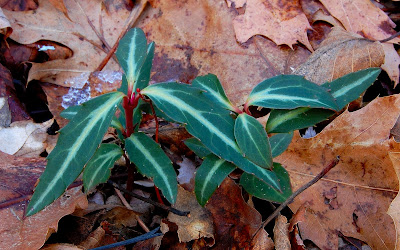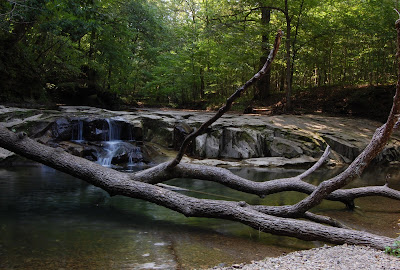Photo taken in September in northcentral Indiana. Good luck, and happy new year!
********************
Too easy, I guess. Keith quickly correctly identified the plant above as Solidago flexicaulis. Nice call, Keith!

Good call, Scott! It is Viola pedata, Birdfoot Violet, a denizen of the dry country. It's especially at home in dry sand among a thin growth of Black Oak and Sassafras in the northern third of Indiana. Charles Deam also found it on sandstone ridges in a few counties along the southern edge of the state.
Birdfoot Violet at Ober Savanna Nature Preserve, Starke County, Indiana

The winter leaves are markedly different than those of the growing season. In winter, the leaves are coriaceous (thick and leathery), on very short petioles, usually very purple, and the lobes are short and wide. New leaves emerge in spring with long and very narrow lobes. Here's a photo of purple winter leaves and the old, withered leaves lying on the ground.



Good call, "Euphorb!" It is Epigaea repens, Trailing Arbutus. At home on acid slopes, this tiny native shrub stays green all winter and flowers in April and May. The flowers emit a very strong, very attractive spicy fragrance that can be detected from a distance. Look for it on the steepest slopes, especially cool north and east-facing ones where mosses are abundant. A photo of this plant in flower is posted below.


 The french fur trappers who came through the Great Lakes region called this delightful little subshrub Petit the de bois meaning "little tea of the woods." It's the plant we know as Wintergreen or Teaberry, Gaultheria procumbens, and it has an enjoyable wintergreen flavor and aroma. Find a forest with sandy, acid soil and this tiny shrub is a possibility. It's one of several native plants that stay green all winter and add color to the winter landscape.
The french fur trappers who came through the Great Lakes region called this delightful little subshrub Petit the de bois meaning "little tea of the woods." It's the plant we know as Wintergreen or Teaberry, Gaultheria procumbens, and it has an enjoyable wintergreen flavor and aroma. Find a forest with sandy, acid soil and this tiny shrub is a possibility. It's one of several native plants that stay green all winter and add color to the winter landscape.




Last summer while botanizing a railroad in

Drawing closer I was startled to see uncinate spines on the indurated glumes and/or lemmas. It's difficult to tell what's a glume and what's a lemma on this unusual grass.

It turns out to be a little weed of limited distribution called Stalked Bur Grass, Tragus racemosus. According to literature, it catches in lambs' wool and shows up around woolen mills but does not persist.


Further exploration revealed two more colonies along this same track in neighboring
 This tiny, floating aquatic fern is occasional on quiet backwaters in northern Indiana. It usually bears a reddish color, making it stand out from the little duckweeds with which it grows. Its reproductive cycle is much different than terrestrial ferns (it produces separate male and female spores, each producing their own gametophyte), and it lives in symbiosis with a blue-green algae, Anabaena azollae, which fixes atmospheric nitrogen. There is debate on identification of two species in the Midwest: Azolla caroliniana and Azolla mexicana.
This tiny, floating aquatic fern is occasional on quiet backwaters in northern Indiana. It usually bears a reddish color, making it stand out from the little duckweeds with which it grows. Its reproductive cycle is much different than terrestrial ferns (it produces separate male and female spores, each producing their own gametophyte), and it lives in symbiosis with a blue-green algae, Anabaena azollae, which fixes atmospheric nitrogen. There is debate on identification of two species in the Midwest: Azolla caroliniana and Azolla mexicana. 
 |
| A more typical leaf |
 |
| Flower heads |


A rare hybrid of Walking Fern and Ebony Spleenwort is called Pinnatifid Spleenwort, Asplenium pinnatifidum. It sometimes shows up on a damp rock shelf beneath an overhanging outcrop.
Asplenium pinnatifidum, Pinnatifid Spleenwort
 Any trip to central or southern Indiana should include waterfall photos. They're tough to find right now, however, as many are almost completely dried up
Any trip to central or southern Indiana should include waterfall photos. They're tough to find right now, however, as many are almost completely dried up


 It's an unusual plant for many reasons, but its strangest characteristic is the timing of anthesis. Most plants have three flower buds, and all plants in a forest will open their first flower on the same day, as if they could communicate. Twins like the ones shown here are only occasional.
It's an unusual plant for many reasons, but its strangest characteristic is the timing of anthesis. Most plants have three flower buds, and all plants in a forest will open their first flower on the same day, as if they could communicate. Twins like the ones shown here are only occasional.
 The flowers only last a day, and about two or three days later, the second set of buds will open, an so on. If your timing is not perfect, you are not likely to see the plant in flower.
The flowers only last a day, and about two or three days later, the second set of buds will open, an so on. If your timing is not perfect, you are not likely to see the plant in flower.
 It sometimes lies dormant for several years, then suddenly flowers show up in mass profusion. After initially seeing this plant in 1996, open flowers eluded me until now. I owe a special debt of gratitude to Pete Grube for keeping me posted on the status of the plants, or I probably would have forgotten about this species entirely.
It sometimes lies dormant for several years, then suddenly flowers show up in mass profusion. After initially seeing this plant in 1996, open flowers eluded me until now. I owe a special debt of gratitude to Pete Grube for keeping me posted on the status of the plants, or I probably would have forgotten about this species entirely.










